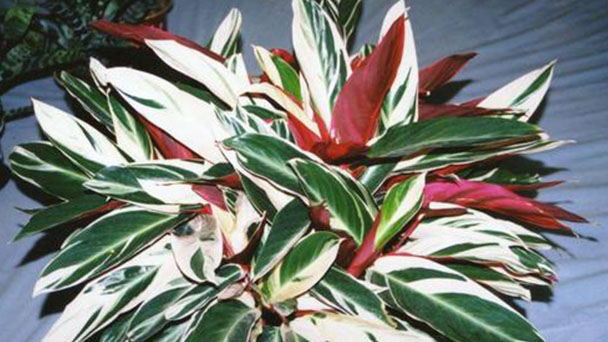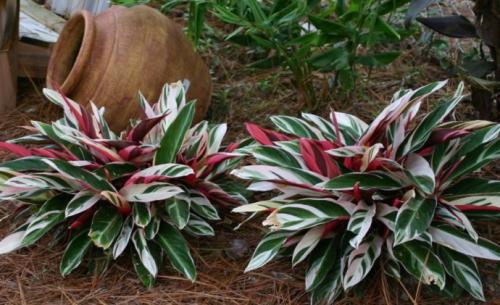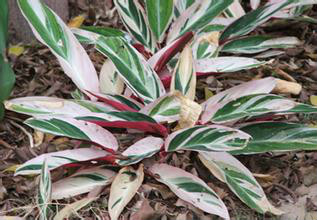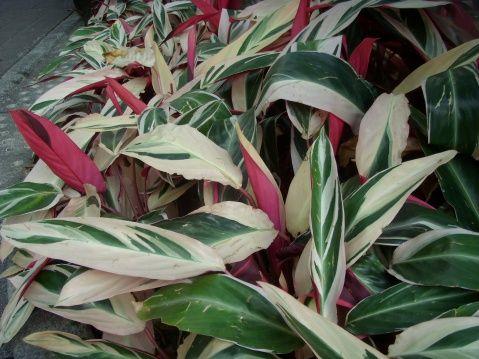Never Never Plant (Ctenanthe Oppenheimiana) Profile
Written by Maggie
Nov 10 2021

Never Never Plant, scientific name Ctenanthe oppenheimiana, is a perennial herbaceous, plant height 30 ~ 60cm, underground rhizome, fascicular.
Never Never Plant Picture

Never Never Plant Quick Info
| Botanical/Scientific Name | Ctenanthe Oppenheimiana |
| Common Name | Brazilian Snow Plant |
| Uses | Ornamental, evergreen perennial indoor house plant |
| Origin | Northeast Brazil |
| Light Care | Away from direct light |
| Soil Care | Draining soil |
| Temperature Care | Between 55-85F |
| Humidity Care | High humidity |
| Watering | Do not let the plant dry out |
| Pruning Care | Trim any dead growth |
| Fertilizer Care | Fertilize monthly during the growing season with half strength fertilizer |
| Propagation | Stem cuttings or division |
| Toxic | Non-toxic to pets |
| Flower Color | Small white/yellow flowers |
Never Never Plant Characteristics
Root leaves of Never Never Plant is long elliptic-lanceolate, entire, dark green, with pale green, white to pale pink pinnate spots, petiole and leaf back dark red.
Never Never Plant Habits
Humus soil or sandy loam soil is the best cultivation soil, drainage should be good. Cut off aged leaves of never never plant at any time. Never never plant likes high temperature and high humidity. Small, insignificant white/yellow flowers appear at intervals through the year when grown in good conditions.
Never Never Plant Use
The leaf color of Never Never Plant is bright and gorgeous. Never Never Plant is resistant to shade, the growth is dense, is suitable for the garden shade place clong planting, makes the ground cover or the small potted plant, is the senior indoor plant.
How to Care for Never Never Plant
The silver and green striped foliage of the Never Never Plant will bring a touch of the tropics into your home, even if you live in areas where the long and cold winters are a far reach from the sun and heat of the rainforest.
The Never Never Plant is renowned for the lance or spear-shaped leaves whose dark green foliage are punctuated by sliver stripes or bands. These silver bands are what also give the Never Never Plant its other common name: The Brazilian Snow Plant. Though small flowers may appear, most home gardeners keep the plant for its impressive foliage display.
This tropical evergreen plant requires specific growing conditions that mimic the humidity, temperature, light levels, and soils of its native tropical rainforest habitat. Without these conditions, the plant can still grow, but will not fully develop the unique foliage coloration which is what is most prized by plant lovers around the world.
Never Never Plant Watering
Watering: Maintain moist soil, but avoid waterlogged conditions. Water once the top of the soil feels dry.For the indoor potted never never plant, we should pay attention to cleaning its leaves every two or three weeks to avoid too much dust on the leaves. Regular cleaning of the leaves can make it carry out photosynthesis better and promote its growth faster.
It is necessary to replenish water frequently for the maintenance of never never plant. If the soil is dry for a long time, it is very unfavorable to its growth, and the plant leaves will droop. As long as the temperature can be maintained between 18 ~ 28 degrees and there is appropriate light, the soil can be kept slightly wet. When the soil is dry three centimeters below the surface, it can be directly watered. However, when the temperature is relatively low in winter, Keep the soil slightly dry.
Never Never Plant Soil Care
Soil: Nutrient rich, well-draining potting mix. Equal parts potting soil, peat and perlite works well.Never never plant does not have high requirements for soil. It likes humidity and tide. Do not harden airtight mud! It's best to use soft and thick soil, which is more breathable, better breathing and more abundant nutrients. We can use humus soil, loose, breathable and nutritious soil is better! We can also evenly mix rotten leaf soil, part of river sand and a piece of sawdust into flower soil.
Never Never Plant Light Requirements
Light Requirements: Bright, indirect light. Avoid excessive direct sunlight.Never never plant does not have a high demand for light, which makes never never plant more suitable for indoor aquaculture. After all, the place with the best indoor lighting is basically located on the balcony, but the demand for potted plants is almost all indoor. But this does not mean that never never plant does not need any sunshine at all. In particular, the never never plant in the seedling stage needs sufficient light to lay a good foundation. If it is too shaded in the later stage of growth, it will also fall down. However, it is strictly prohibited to expose and direct it at noon in summer.
Never Never Plant Temperature
Temperature: 55-85°F (13-29°C).Generally speaking, the general family propagating never never plant is OK, but it is difficult for the growth of bamboo taro to reach a good state indoors in summer. Too low or too high temperature will make the growth of bamboo taro stagnate, and seriously endanger the life of the plant. Therefore, before maintaining never plant, we must first consider whether its conditions are met.
Never Never Plant Humidity
Humidity: Medium to high humidity. Leaf curling and brown tips will develop in low humidity.Never never plant likes humid environment, which is also an important feature that is more suitable for family indoor breeding. Never Never Plant watering interval should not be too long, while other leaves of the arrowroot cultivar can be appropriately increased watering interval, but not too dry in the basin soil. In some areas with high summer temperature and low indoor temperature, we'd better use spray around to increase the humidity in the air.
Never Never Plant Fertilizer
Fertilizer: Balanced, water-soluble fertilizer applied monthly while the plant is actively growing.It is not a large-scale planting. Few families buy fertilizer to apply flowers and plants. Never never plant also meets this requirement. Too thick fertilizer is a burden on it. If the roots do not grow well at the beginning of seedling or transplanting, appropriate fertilizer can be applied to assist the growth of roots. However, we usually buy shaped never plant when we raise never plant every day, so we don't have to worry too much.
Never Never Plant Pruning
Pruning: Only needed to control size and remove dead foliage. Plant will spread out if allowed to.During the maintenance of never never plant, once the dried and curled leaves of bamboo and taro are found, it is necessary to use scissors to cut off the dried and curled parts of never plant leaves in time, which can reduce the consumption of excess nutrients, prevent the continuous spread of dried parts, avoid infection of other leaves and make the leaves more green. The pruned taro can retain healthy leaves, and properly sprinkle water on the leaf surface to keep the growth environment of never plant moist, effectively promote the growth of leaves and avoid the dry and curly phenomenon of other leaves again.
If your never plant has been propagated for several years, there must be very old branches and buds on the plant. Those aged branches and buds will be darker at night, and the branches and stems will be too thick, which will greatly affect the beauty. Moreover, this old branch absorbs a lot of nutrients. Only by cutting off this already very old branch and bud, the plant will have sufficient nutrients to transport to the new young leaves.
Many people will be curious about how to trim when they see never plant. In fact, never plant pruning has only one requirement, that is, good-looking. In order to make the plant more ornamental, when pruning, just cut all the bad leaves inside. In particular, the yellow leaves, whether due to drying and dehydration or disease, can only be cut off to make the plant more beautiful.
Never Never Plant Repotting
Repotting: Every 1-2 years in springtimeFor this plant, timely never never plant repotting is more important, because the leaves of Malachite bamboo taro are large and plump, the plant growth speed is relatively fast, and a large amount of nutrient supply is required to meet the growth needs of the whole plant. In addition, due to the rapid growth of peacock bamboo taro, the old basin can not better accommodate the whole plant after growing to a certain extent, which virtually hinders the downward extension of root system and is not conducive to the development of root system. Only by replacing the basin soil in time can we solve a series of problems such as limited growth space and insufficient nutrients in the basin soil, and better promote the growth of never plant, Let the leaves emit charming colors.
The best pot change time of never plant is around April in spring. At this time, the light is relatively mild and the temperature basically tends to be stable (about 20 ℃), and the plant activity is relatively strong at this time. Therefore, selecting pot change at this time can accelerate the growth of new roots and greatly improve the success rate of never never plant repotting.
Popular Varieties of Never Never Plant
- C. burle-marxii
- C. oppenheimiana
- C. marantifolia

Never Never Plant Diseases & Pests
Fairly resistant. Botrytis develops in excessively moist conditions. Ctenanthe oppenheimiana can get mealybugs, thrips and spider mites.
Never Never Plant Toxicity
Never Never Plant is generally safe for children and pets.

Never Never Plant Propagation
Never Never Plant Cutting Propagation
Never never plant cutting propagation is generally carried out when the temperature is not lower than 20 ℃, and can be carried out in any season. Never never plant cutting propagation generally uses the top young shoots, and the length of the cuttings cut off should be 10-15 cm. If the leaves grow vigorously, one third of the leaves need to be retained. If the leaves grow weakly and small, one half of the leaves need to be retained.
Before never never plant cutting propagation, we can soak the cuttings in 500ppm Nai acetic acid solution for 2-3 seconds, or treat them with indole acetic acid, indole butyric acid and ABT rooting powder.
After treatment, insert the cuttings obliquely into the seedbed or flowerpot. If mass propagation is carried out, the plant row spacing of double-line bamboo taro should be 5 × About 10 cm, so as to ensure the normal growth of the plant. After cutting, never plant is covered with film, and the temperature is controlled at 20 ℃ - 30 ℃ and the air relative humidity is 75% - 85%. The survival rate of cutting of never never plant is lower than that of plant propagation, about 50%, so it is best to adopt the method of plant propagation in general family propagation.
Never Never Plant Division Propagation
Never never plant division propagation is the most commonly used propagation method of never never plant, which is generally carried out when the temperature reaches about 20 ℃ in spring.
The soil of flowerpot or seedbed shall be slightly acidic soil rich in humus, which is generally mixed with rotten leaf soil and peat soil. We can also mix pond mud, peat and perlite in the ratio of 2:3:1; Or it is made of loose rotten leaf soil rich in organic matter, 1 / 3 perlite and a small amount of base fertilizer.
First, we can use a sharp blade to cut the root block with stem, leaf or leaf bud. If it is family farming and the quantity demand is small, we can directly place the cut root block with stem, leaf and leaf bud in the flower pot of never never plant; If it is mass breeding, it should be placed in the seedbed.
We should keep the ambient temperature at 20 ℃ - 28 ℃ and the relative humidity above 80%. If the temperature and humidity cannot reach, we need to cover a layer of film on the flowerpot or seedbed.
Latest Updated
- Benefits of Bugleweed - 7 Science-backed Health Benefits
- Bugleweed Dangers & Side Effects - Is It Poisonous?
- How to Plant Evergreen Trees - What You Should Know
- When to Plant Evergreens - Grow Guide for Evergreen Trees
- 12 Wonderful Evergreen Shrubs for Your Garden
- 12 Popular Evergreen Plants with Pictures for Beginners
- When And How To Prune A Lilac Bush Like a Pro
- How to Grow & Care for Lilac Vine (Hardenbergia Violacea)
- Japanese Lilac Tree (Syringa Reticulata) Care & Propagation Guide
- Shumard Oak Pros and Cons - What to Know
Popular Articles
- Winter maintenance of Antirrhinum Majus
- How to Grow Terminalia Mantaly Tree
- How to Grow and Care for Crossostephium Chinense
- How to grow Antirrhinum Majus in spring
- Peristeria Elata (Dove Orchid) Profile: Info & Care Guide
- Underwatered Snake Plant (Sansevieria Trifasciata) - Signs And How To Fix
- How to Care for Brazilian Jasmine Plant (Mandevilla Sanderi)
- How to Grow & Care for Graptopetalum Purple Delight in Summer
- Rosa Chinensis (China Rose): Plant Growing & Care Tips
- How to Care for Baby Sun Rose (Aptenia Cordifolia)